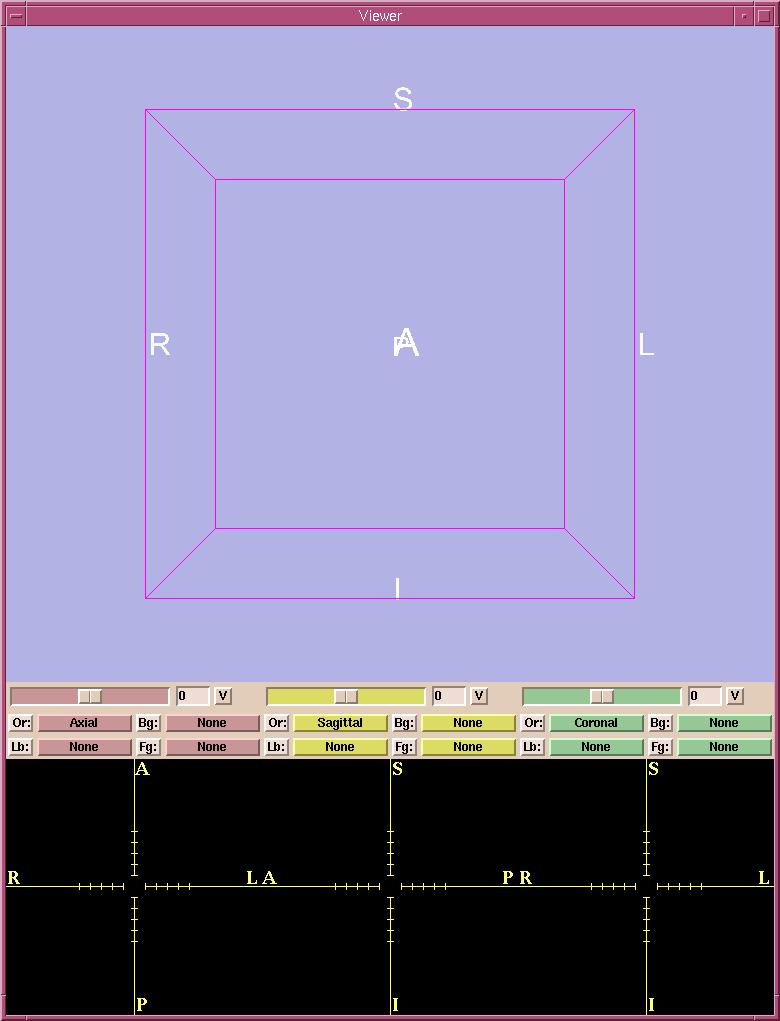Slicer is available for the Solaris 2.8 (also known as Solaris 8 or SunOS 5.8), Windows (98, NT, and 2000),
Red Hat Linux 7.3, and Mac OS X operating systems.
To start Slicer, run the appropriate
launcher executable for your platform (for example, slicer-solaris-sparc, slicer2-win32.exe, or slicer2-linux-x86).
After Slicer starts, two windows appear.

|
The Menu window provides menus for accessing the features
of Slicer. A brief explanation of the Menu window will make it easier to refer
to its parts later.
At the top of the Menu window there are File, View, and Help submenus.
Under the submenus
is a group of buttons known as the Main menu.
Clicking a button
on the Main menu will take you to the panel associated with
that Slicer feature.
There are tabs along the top of each panel. The leftmost tab on each panel
is the Help for that feature.
|
Clicking More in the Menu window lists the modules
available in your version of Slicer. Since Slicer consists of many optional modules,
your list of modules may not match the list below.

|
Here are some sample modules:
- Locator: connects Slicer to a server that
feeds a real-time stream of coordinates from a device called the locator.
- Realtime: enables the locator's real-time coordinates
to control Slicer.
- Guidance: positions two spherical targets (red
and yellow) in the 3D view window to support reformatting volumes.
- View: customizes the size of the viewer window. The stereo
mode allows viewing the 3D window in 3 dimensions, using red/blue glasses.
- Anno: controls the annotation displayed
in the 2D and 3D viewer.
- Slices: selects the slices to display in the
3D viewer window.
- Colors: enables you to create your own color palette.
- EMSegment: implements the "Expectation-Maximization-Segment"
algorithm.
- Custom: enables you to create your own
modules for Slicer.
- Anatomy: saves files from a Slicer scene to use with the SPL Anatomy Browser.
- CustomCsys: lets developers add a Coordinate
System actor to their module.
- Endoscopic: places and controls a virtual endoscope
in Slicer's scene, and presents the endoscope's view in a second window.
- Measure: provides measuring tools to calculate
Surface Area, Volume, and Cross Sectional Area.
- Fiducials: adds fiducial points on models in the 2D or 3D viewer windows.
- MeasureVol: measures the volume of a segmented
structure in a label map.
- ModelHierarchy: displays the hierarchy of models.
- Options: reorganizes the order of the modules and
hides unnecessary modules.
- SessionLog: records information about a segmentation
session for Slicer development purposes.
- Tester: allows the developer to test modules.
- TetraMesh: reads in a Tetrahedral Mesh and converts
it into a model.
- VolRend: selects the volume rendering method: Composite,
MIP (Maximum Intensity Projection), or Isosurface.
- VolumeMath: adds and subtracts volumes; finds the distance
between two points in a volume.
- ModelCompare: shows point correspondences and models in 2D.
|
The Viewer window (below) displays volumes and models.
The upper part of the Viewer window is the 3D viewer and the lower
part displays the corresponding 2D slices.




